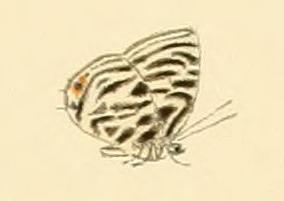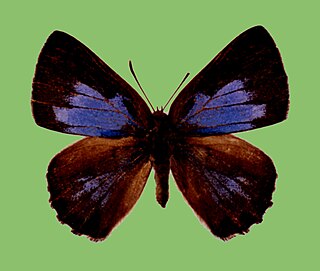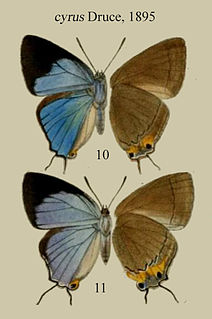
Lycaenidae is the second-largest family of butterflies, with over 6,000 species worldwide, whose members are also called gossamer-winged butterflies. They constitute about 30% of the known butterfly species.

Riodinidae is the family of metalmark butterflies. The common name "metalmarks" refers to the small, metallic-looking spots commonly found on their wings. The 1532 species are placed in 146 genera. Although mostly Neotropical in distribution, the family is also represented both in the Nearctic and the Palearctic.

Myrmecophily is the term applied to positive interspecies associations between ants and a variety of other organisms, such as plants, other arthropods, and fungi. Myrmecophily refers to mutualistic associations with ants, though in its more general use, the term may also refer to commensal or even parasitic interactions.

Miletus is a genus of butterflies sometimes called brownies. Its species are found in the eastern Palearctic realm and the Indomalayan realm, and some stray east of the Wallace Line. The genus was erected by Jacob Hübner around 1819. Miletus is the type genus of the subfamily Miletinae.

Liphyra is a butterfly genus in the family Lycaenidae. It was first described by John O. Westwood in 1864. The larvae are predatory and feed on ant larvae. They are among the largest species of lycaenid butterflies. There are several species in the genus which are found in Asia and Australia. In the genus Liphyra, the antenna tapers gradually.

Anthene is a genus of butterflies in the family Lycaenidae, commonly called the ciliate blues or hairtails. The genus was erected by Edward Doubleday in 1847.

Catapaecilma is a genus of butterflies in the family Lycaenidae. The species of this genus are found in the Indomalayan realm.

Oenomaus is a genus of butterflies in the family Lycaenidae. The species of this genus are found in the Neotropical realm.

Spalgis is a genus of butterflies in the family Lycaenidae. Spalgis are found in the Australasian realm, the Indomalayan realm, and the Afrotropical realm. The genus was erected by Frederic Moore in 1879.

Myrina subornata, the West African fig-tree blue or small fig blue, is a butterfly in the family Lycaenidae. It is found in Senegal, Guinea-Bissau, Burkina Faso, Guinea, Ghana, Nigeria, Cameroon, the Republic of the Congo, Uganda, Sudan and possibly Kenya. The habitat consists of savanna.
Iolaus menas, the blue savanna sapphire, is a butterfly in the family Lycaenidae. The species was first described by Hamilton Herbert Druce in 1890. It is found in Senegal, the Gambia, Burkina Faso, Guinea, Ivory Coast, Ghana, Nigeria, Cameroon, Sudan, Ethiopia, Uganda and Kenya. The habitat consists of savanna.
Dapidodigma demeter, the eastern virgin, is a butterfly in the family Lycaenidae. It is found in Africa, specially in the Ivory Coast, Ghana, Benin, Nigeria, Cameroon, the Republic of the Congo, Sudan, Angola, the Democratic Republic of the Congo, Zambia and Uganda. The habitat consists of rainforests.
Anthene wilsoni, the Wilson's hairtail or Wilson's ciliate blue, is a butterfly in the family Lycaenidae. It is found in Ghana, northern Cameroon, southern Sudan, south-western Ethiopia, north-eastern Uganda, western Kenya, western Tanzania, Zambia and north-eastern Zimbabwe. The habitat consists of wet parkland savanna and dry savanna.

Anthene lamias, the blotched ciliate blue, is a butterfly in the family Lycaenidae. It is found in Guinea, Sierra Leone, Liberia, Ivory Coast, Ghana, Togo, Nigeria, Cameroon, Gabon, the Republic of the Congo, the Democratic Republic of the Congo, Uganda, Kenya and Tanzania. The habitat consists of primary forests, the forest/Guinea savanna transition zone and secondary forests.

Deudorix smilis is a butterfly in the family Lycaenidae. It was described by William Chapman Hewitson in 1863. It is found in the Indomalayan realm.

Deramas nelvis is a butterfly in the family Lycaenidae. It was described by John Nevill Eliot in 1964. It is found in the Indomalayan realm.

Jamides aleuas is a butterfly in the family Lycaenidae. It was described by Cajetan Felder and Rudolf Felder in 1865. It is found in the Australasian realm.

Tajuria deudorix is a species of lycaenid or blue butterfly found in the Indomalayan realm

Tajuria jalajala is a species of lycaenid or blue butterfly found in the Indomalayan realm

Tajuria megistia,the black royal is,a species of lycaenid or blue butterfly found in the Indomalayan realm.
















